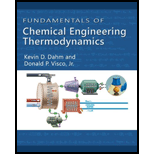
(A)
Interpretation:
The rate at which the work is done
Concept Introduction:
Write the molar entropy equation for a reversible, steady-state, adiabatic turbine.
Here, final molar entropy of the fluid leaving the turbine is
Write the expression to calculate the Lee Kesler correlation residuals entropy.
Here, final molar entropy for an ideal gas state is
Write the expression to calculate the reduced temperature
Here, critical temperature is
Write the expression to calculate the reduced pressure
Here, critical pressure is
Calculate parameter
Here, constant volume heat capacity on a molar basis for ideal gas is
Write the energy balance for a reversible turbine.
Here, rate of shaft work for reversible turbine is
Write the expression to calculate the Lee Kesler correlation residuals enthalpy.
Here, final molar enthalpy is
(A)
Explanation of Solution
Given information:
n-butane.
Flow rate five moles per second.
Inlet pressure is 15 bar and temperature is 500 K.
Final pressure is 1 bar.
Isentropic efficiency is 80%.
Refer the Appendix table C 1, “Physical properties”, obtain the critical properties of butane.
Critical temperature,
Critical pressure,
Acentric factor,
Calculate the reduced temperature
Substitute
Calculate the reduced pressure
Substitute
Refer the Figure 7-18, “Molar entropy residual function for a compound with
Refer the Figure 7-19, “Correction to molar entropy residual function for a compound with
Calculate parameter
Substitute
Calculate the Lee Kesler correlation residuals entropy.
Re-write the Equation (4).
Substitute 0 for
Refer the Appendix D, “Heat capacity”; obtain the ideal gas heat capacity of a compound as a function of temperature.
Here, constants are A, B, C, D, and E.
Calculate parameter
Substitute
Refer the appendix table D.1, “Ideal Gas Heat Capacity”, obtain the constants for the butane.
| Name | Formula | A | ||||
| Butane | 5.547 | 5.536 | 8.057 | –10.571 | 4.134 |
substitute
Solve Equation (8) to obtain the final temperature:
Calculate the Lee Kesler correlation residuals enthalpy.
Re-write the Equation (8).
Refer the Figure 7-16, “Molar enthalpy residual function for a compound with
Refer the Figure 7-17, “Correction to the molar enthalpy residual function for a compound with
Calculate parameter
Substitute
Calculate parameter
Substitute
substitute
Substitute
Calculate the actual work is done
Substitute 80% for
Thus, the rate at which work is done is
(B)
Interpretation:
The rate at which the work is done
Concept Introduction:
Write the reduced temperature
Here, critical temperature is
Write the reduced pressure
Here, pressure is
Write the acentric factor in a manner analogous to Soave’s
Write the
Write the Peng-Robinson parameter a at the critical point.
Write the van der Waals parameter
Write the van der Waals parameter
Write the Peng-Robinson equation.
Here, molar volume is
Write the compressibility factor.
Write the residual properties of A.
Write the residual properties of B.
Write the compressibility factor
Write the expression to calculate the Lee Kesler correlation residuals enthalpy.
Here, final molar enthalpy is
(B)
Explanation of Solution
Calculate accentric factor in a manner analogous to Soave’s
Substitute
Calculate the value of
Substitute
Calculate the value of parameter a at the critical point.
Substitute
Calculate the van der Waals parameter
Substitute
Calculate the van der Waals parameter
Substitute
Calculate constant A.
Substitute
Calculate constant B.
Substitute
Calculate the molar volume
Substitute
Calculate the compressibility factor
Substitute
Calculate parameter
Substitute
substitute
Refer the Figure 7-16, “Molar enthalpy residual function for a compound with
Refer the Figure 7-17, “Correction to the molar enthalpy residual function for a compound with
Calculate the term
Substitute
Calculate the Lee Kesler correlation residuals enthalpy.
Re-write the Equation (27).
Substitute
Calculate the actual work is done
Substitute 80% for
Thus, the rate at which work is done is
Want to see more full solutions like this?
Chapter 7 Solutions
Fundamentals of Chemical Engineering Thermodynamics (MindTap Course List)
 Introduction to Chemical Engineering Thermodynami...Chemical EngineeringISBN:9781259696527Author:J.M. Smith Termodinamica en ingenieria quimica, Hendrick C Van Ness, Michael Abbott, Mark SwihartPublisher:McGraw-Hill Education
Introduction to Chemical Engineering Thermodynami...Chemical EngineeringISBN:9781259696527Author:J.M. Smith Termodinamica en ingenieria quimica, Hendrick C Van Ness, Michael Abbott, Mark SwihartPublisher:McGraw-Hill Education Elementary Principles of Chemical Processes, Bind...Chemical EngineeringISBN:9781118431221Author:Richard M. Felder, Ronald W. Rousseau, Lisa G. BullardPublisher:WILEY
Elementary Principles of Chemical Processes, Bind...Chemical EngineeringISBN:9781118431221Author:Richard M. Felder, Ronald W. Rousseau, Lisa G. BullardPublisher:WILEY Elements of Chemical Reaction Engineering (5th Ed...Chemical EngineeringISBN:9780133887518Author:H. Scott FoglerPublisher:Prentice Hall
Elements of Chemical Reaction Engineering (5th Ed...Chemical EngineeringISBN:9780133887518Author:H. Scott FoglerPublisher:Prentice Hall
 Industrial Plastics: Theory and ApplicationsChemical EngineeringISBN:9781285061238Author:Lokensgard, ErikPublisher:Delmar Cengage Learning
Industrial Plastics: Theory and ApplicationsChemical EngineeringISBN:9781285061238Author:Lokensgard, ErikPublisher:Delmar Cengage Learning Unit Operations of Chemical EngineeringChemical EngineeringISBN:9780072848236Author:Warren McCabe, Julian C. Smith, Peter HarriottPublisher:McGraw-Hill Companies, The
Unit Operations of Chemical EngineeringChemical EngineeringISBN:9780072848236Author:Warren McCabe, Julian C. Smith, Peter HarriottPublisher:McGraw-Hill Companies, The





